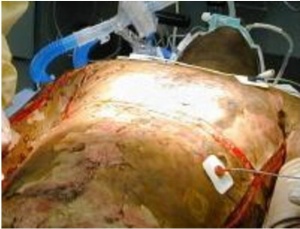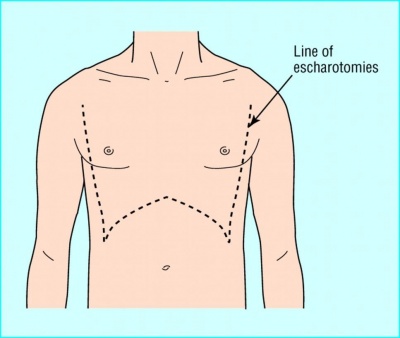Emergency Escharotomy: Difference between revisions
From Protocopedia
mNo edit summary |
|||
| Line 30: | Line 30: | ||
[[File:Escharotomy.jpg|none|400px|]] | [[File:Escharotomy.jpg|none|400px|]] | ||
[[Category:Procedure Guidelines]] | [[Category:Procedure Guidelines|0932]] | ||
Latest revision as of 17:47, 1 February 2018
Procedure Guidelines
9.32 Emergency Chest Wall Escharotomy
DEFINITION:
- The Emergency Chest Wall Escharotomy is indicated when full-thickness circumferential and near-circumferential skin burns over the torso result in the formation of a tough, inelastic mass of burnt tissue (eschar). The eschar, by virtue of this inelasticity, results in the burn-induced significant compromise of chest wall excursions and can hinder ventilation. Similarly, airway patency and venous return may be compromised by circumferential burns involving the neck.
- Emergency Chest Wall Escharotomy is the surgical division of the nonviable eschar, which allows the cutaneous envelope to become more compliant. Hence, the underlying tissues have an increased available volume to expand into, preventing further tissue injury or functional compromise (see image below).

INDICATIONS:
- Patients presenting with circumferential or near-circumferential 2nd degree or higher burns to the torso with an impending or established respiratory compromise as a result of the burns.
CONTRAINDICATIONS:
- On patients with an impending or established respiratory/ventilator compromise as a result of circumferential or near-circumferential 2nd degree or higher burns to the torso there are no contraindications for this procedure.
COMPLICATIONS:
- May include continued respiratory compromise due to inadequate ventilation as a result of a partial or incomplete release of eschar.
- Excessive bleeding
- Incision or injury to underlying healthy tissue including neurovascular structures
- Infection
PROCEDURE:
- The patient is placed in a supine position while maintaining ventilatory support efforts.
- Time permitting – cleanse the area of any excess debri or loose clothing.
- Utilizing a surgical scalpel carry the incision of the eschar down through the level of the subcutaneous fat. An immediate release in tissue pressure is experienced often as a discernible popping sensation.
- Carry the incisions approximately 1 cm proximal, lateral and distal to the extent of the burn.
- Once the escharotomy is performed, monitor for improvement in ventilation as evidenced by improved compliance of ventilations using a bag/valve device, visible chest rise and improvements in oxygen saturation.
- If improved compliance is not seen after the initial incision, revise the escharotomy in an attempt to improved ventilatory support.
- Once completed, cover the torso / chest wall area with a sterile burn sheet.
- Maintain continuous monitoring of the patient’s respiratory compliance and oxygenation.

